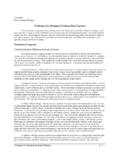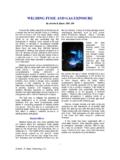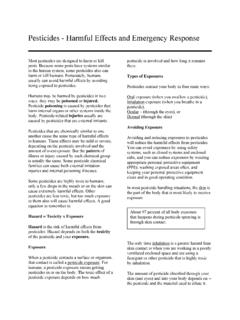Transcription of 4 Exposure and health risks from incineration - WHO
1 24and the community. This should include the use of approved incinerator designs that can achieve appropriate combustion conditions ( , minimum temperature of 800 C, minimum chimney heights); appropriate siting practices ( , away from populated areas or where food is grown); adequate operator training (including both classroom and practical training); appropriate waste segregation, storage, and ash disposal facilities; adequate equipment maintenance; managerial support and supervision; and sufficient budgeting. 4 Exposure and health risks from incineration Section presents the conceptual framework of health risk assessment (HRA), as well as some details and citations supporting the approach.
2 Subsequent sections apply this approach to small-scale incinerators. health risk assessment framework The objective of HRA is to estimate effects of incinerator emissions, in this case, air pollutants, on human health , including short-term acute impacts (systemic diseases) and chronic (long-term) impacts ( , cancer). The goal generally is to assess the overall risk associated with Exposure to emissions, , the risk quantified as the probability of harm, the fraction of the population potentially affected, and/or the number of cases of disease. Historically, health concerns raised by incineration focused on communities living near the incinerator. More recently and rather definitively, the NRC (1999) identified three potentially exposed populations: (1) the local population, which is exposed primarily through inhalation of airborne emissions; (2) workers at the facility, especially those who clean and maintain the pollution control devices; and (3) the larger regional population, who may be remote from any particular incinerator, but who consume food potentially contaminated by one or more incinerators and other combustion sources that release persistent and bioaccumulative pollutants The analysis will follow the general steps of hazard assessment, toxicity assessment, Exposure assessment, and risk characterization, as summarized below.
3 The assessment is screening in nature, as described below. Hazard assessment In hazard assessment, causative agents are identified and the feasibility of linkages and mechanisms between air pollutants and adverse health effects are demonstrated. Much of this has been completed by the development of lists of priority chemicals, regulations, etc. Dose-response assessment The dose-response assessment describes the toxicity of the chemicals identified above using models based on human (including clinical and epidemiologic approaches), and animal studies. Dose-response relationships depend on the pollutants: Systemic toxicants. Many studies have indicated a threshold or 'no-effect' level, that is, an Exposure level where no adverse effects are observed in test populations, as cell mechanisms are able to repair or isolate damaged cells.
4 Some health impacts may be reversible once the chemical insult is removed. In this case, a reference dose or concentration, for use in the risk characterization as a component of the hazard index. Carcinogens. Both linear and nonlinear dose-response models are used for carcinogens. With linear models, doubling the Exposure doubles the predicted risk. Cancer potencies are typically provided for each Exposure pathway or for total intake. 25 Conventional pollutants, , particulate matter and SO2. Dose-response relationships for morbidity and mortality are often derived using epidemiological studies. High quality peer-reviewed databases should utilized, , US EPA s Integrated Risk Information System (IRIS), WHO, IARC, etc.
5 It is important to realize that these databases are primarily useful for long-term exposures to toxics. The dose-response analysis involves a review of the literature to summarize the basis of the dose-response relationship, the nature of studies, health endpoints, the weight of the evidence, uncertainties, extrapolations, and other adjustments used to derive the dose-response relationship. Analyses should emphasize those agents that are judged to cause most of the risks and human health impacts. Exposure assessment The Exposure assessment identifies exposed populations and details the type, level, duration and frequency of Exposure . Typically, Exposure assessment consists of a number of steps. Estimation of ambient air concentrations using air pollution monitors or other predictive air quality models, including analysis of spatial and temporal trends and distributions Identification of any special groups that may be at risk due to high Exposure (due to proximity, diet, or other factors) or vulnerability (due to preexisting disease or other factors) to the pollutants.
6 Special groups often include children and pregnant women. Development of appropriate Exposure assumptions, , activity factors ( , time spent outdoors), locational factors (mobility), uptake/dosimetry factors (breathing rates, absorption rates, etc.), and other factors that may affect Exposure to pollutants for each group. Estimation of the numbers of exposed individuals based on demographic and other data. Validation of Exposure analysis using monitoring or other means. Several Exposure pathways may pose risks . Figure 6 provides the conceptual framework for the HRA recently used for air toxics in the US. Only the portion in bold in the figure was attempted in this large study. This diagram is useful for orientation purposes as it describes linkages from emission sources to measures of health risk impacts.
7 The indirect Exposure pathways for air pollutants may pose significant health risks in certain settings. These pathways may include, for example, consumption of locally produced meat, eggs, and dairy products, consumption of fish from local waterways that are contaminated by air pollutants, and dermal contact with contaminated soils. These pathways are important for persistent pollutants that can bioaccumulate into food, a result of the deposition of toxic emissions onto plants and soil with subsequent ingestion by farm animals, or, in the case of fish contamination, from deposition directly into water bodies or onto soil and runoff into surface waters with subsequent uptake in fish. Indirect Exposure pathways can be important for dioxins, furans and other emissions if: Food is grown near the incinerator.
8 Animals are raised on fields near the incinerator. Lakes, ponds, or other surface drinking water sources have a local catchment area. Subsistence fishers or farmers in the area obtain most of their food from local sources. Children play in dirt subjected to significant atmospheric deposition. Modeling of indirect Exposure pathways involves considerable uncertainty and difficulties for several reasons: (1) The methodology is relatively new, complex, under refinement and peer review; (2) substantial site-specific parameters that may not be available are required; and (3) validation efforts using measurements of contaminants along the pathway ( , in food, blood, urine, etc.) are tremendously important to ensure model credibility and the significance of air emission sources.
9 Indeed, recent follow-up studies in developed countries have collected and analyzed a sufficient number of samples to characterize trace metals, dioxin/furans, and other pollutants emitted from major 26point sources, in soils and foods. Challenges involved in predicting and validating indirect Exposure pathways for small-scale incinerators include: The limited data available on both communities surrounding incinerators (demography, occupations, health status, etc.) as well as environmental conditions (types and concentrations of air contaminants present, etc.) The wide variety of environmental settings. The poor quality of the emission data. The lack of validation of the Exposure assessments.
10 As can be seen, Exposure assessments can be very detailed and data intensive. Given uncertainties, simpler analyses also have a role, and they may be more robust, more transparent, and often more useful. Figure 6 Specific conceptual model for the US National Scale Air Toxics Assessment. From EPA 2003, Framework for Cumulative Risk Assessment. Risk characterization Risk characterization determines the overall risks of Exposure . Generally, multiplicative relationships between the dose-response relationship, pollutant Exposure , and population exposed are used for each chemical and affected population to identify major pollutants causing risks , the magnitude of the risk, the populations with the maximum risk, and the number of people likely to be affected.


















